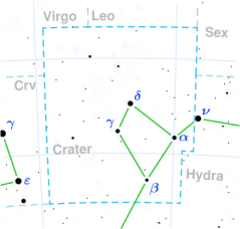Astronomy:Delta Crateris
| Observation data Equinox J2000.0]] (ICRS) | |
|---|---|
| Constellation | Crater |
| Right ascension | 11h 19m 20.44756s[1] |
| Declination | −14° 46′ 42.7413″[1] |
| Apparent magnitude (V) | 3.56[2] |
| Characteristics | |
| Spectral type | K0 III[2] |
| B−V color index | 1.12[2] |
| Astrometry | |
| Radial velocity (Rv) | −4.94±0.21[3] km/s |
| Proper motion (μ) | RA: −124.67[1] mas/yr Dec.: +207.59[1] mas/yr |
| Parallax (π) | 20.0507 ± 0.5308[4] mas |
| Distance | 163 ± 4 ly (50 ± 1 pc) |
| Absolute magnitude (MV) | −0.321[5] |
| Details | |
| Mass | 1.56[6] M☉ |
| Radius | 22.44±0.28[7] R☉ |
| Luminosity | 171.4±9.0[7] L☉ |
| Surface gravity (log g) | 2.59[2] cgs |
| Temperature | 4,510±15[6] K |
| Metallicity [Fe/H] | −0.48[2] dex |
| Rotational velocity (v sin i) | 0.0[3] km/s |
| Age | 2.89[6] Gyr |
| Other designations | |
| Database references | |
| SIMBAD | data |
Delta Crateris (δ Crt, δ Crateris; traditional name: Labrum) is a solitary[9] star in the southern constellation of Crater. With an apparent visual magnitude of 3.56,[2] it is the brightest star[10] in this rather dim constellation. It has an annual parallax shift of 17.56[1] mas as measured from Earth, indicating Delta Crateris lies at a distance of 163 ± 4 light years from the Sun.
This is an evolved orange-hued giant star belonging to the spectral class K0 III. Delta Crateris is a member of the so-called red clump, indicating that it is generating energy through the thermonuclear fusion of helium at its core.[5] The star has an estimated 1.56[6] times the mass of the Sun but has expanded to 22.44±0.28[7] times the Sun's radius.
The metallicity of the star – what astronomers term the abundance of elements other than hydrogen and helium – is only 33% that of the Sun.[2] It is around 2.89[6] billion years old with a rotation rate that is too small to measure; the projected rotational velocity is 0.0 km/s.[3] Delta Crateris is radiating 171.4±9.0 as much luminosity as the Sun from its outer envelope at an effective temperature of 4,510±15 K.[6]
References
- ↑ 1.0 1.1 1.2 1.3 1.4 van Leeuwen, F. (2007), "Validation of the new Hipparcos reduction", Astronomy and Astrophysics 474 (2): 653–664, doi:10.1051/0004-6361:20078357, Bibcode: 2007A&A...474..653V.
- ↑ 2.0 2.1 2.2 2.3 2.4 2.5 2.6 Mallik, Sushma V. (December 1999), "Lithium abundance and mass", Astronomy and Astrophysics 352: 495–507, Bibcode: 1999A&A...352..495M.
- ↑ 3.0 3.1 3.2 Massarotti, Alessandro et al. (January 2008), "Rotational and Radial Velocities for a Sample of 761 HIPPARCOS Giants and the Role of Binarity", The Astronomical Journal 135 (1): 209–231, doi:10.1088/0004-6256/135/1/209, Bibcode: 2008AJ....135..209M.
- ↑ Brown, A. G. A. (August 2018). "Gaia Data Release 2: Summary of the contents and survey properties". Astronomy & Astrophysics 616: A1. doi:10.1051/0004-6361/201833051. Bibcode: 2018A&A...616A...1G. Gaia DR2 record for this source at VizieR.
- ↑ 5.0 5.1 Soubiran, C. et al. (2008), "Vertical distribution of Galactic disk stars. IV. AMR and AVR from clump giants", Astronomy and Astrophysics 480 (1): 91–101, doi:10.1051/0004-6361:20078788, Bibcode: 2008A&A...480...91S.
- ↑ 6.0 6.1 6.2 6.3 6.4 6.5 Luck, R. Earle (2015), "Abundances in the Local Region. I. G and K Giants", Astronomical Journal 150 (3): 88, doi:10.1088/0004-6256/150/3/88, Bibcode: 2015AJ....150...88L.
- ↑ 7.0 7.1 7.2 Berio, P. et al. (November 2011), "Chromosphere of K giant stars. Geometrical extent and spatial structure detection", Astronomy & Astrophysics 535: A59, doi:10.1051/0004-6361/201117479, Bibcode: 2011A&A...535A..59B.
- ↑ "del Crt". SIMBAD. Centre de données astronomiques de Strasbourg. http://simbad.u-strasbg.fr/simbad/sim-basic?Ident=del+Crt.
- ↑ Eggleton, P. P.; Tokovinin, A. A. (September 2008), "A catalogue of multiplicity among bright stellar systems", Monthly Notices of the Royal Astronomical Society 389 (2): 869–879, doi:10.1111/j.1365-2966.2008.13596.x, Bibcode: 2008MNRAS.389..869E.
- ↑ Ridpath, Ian (2012), A Dictionary of Astronomy, OUP Oxford, p. 108, ISBN 978-0199609055, https://books.google.com/books?id=O31j9UJ3U4oC&pg=PA108.
External links
- Kaler, James B., "Delta Crateris", Stars (University of Illinois), http://stars.astro.illinois.edu/sow/deltacrt.html
 |


